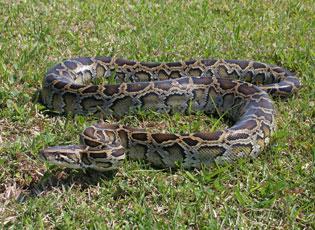Python molurus bivittatus Kuhl, 1820 (ITIS)
Burmese python
Southeast Asia (Harvey et al. 2016)
Established populations were first reported in 2000 (Harvey et al. 2016)
Imported to the U.S. for the pet trade; wild populations became established from animals that escaped or were intentionally released (Harvey et al. 2016)
Preys on native species, some of which are endangered (such as the Key Largo woodrat, Neotoma floridana smalli); may also compete with threatened native species, such as the indigo snake (Drymarchon couperi) (Harvey et al. 2016)
South Florida

Burmese Python in the Everglades
Photo by National Park Service
Find more images
Spotlights
Distribution / Maps / Survey Status
Federally Regulated
Videos
All Resources
Selected Resources
The section below contains highly relevant resources for this species, organized by source.
Partnership
Federal Government
State and Local Government
Harvey, R.G., M.L. Brien, M.S. Cherkiss, et al. 2016. Burmese Pythons in South Florida: Scientific Support for Invasive Species Management [PDF, 1.32 MB]. University of Florida, Institute of Food and Agricultural Sciences Extension. Electronic Data Information Source Publication #WEC242.
Integrated Taxonomic Information System. Python molurus bivittatus. [Accessed Sep 10, 2014].
 An official website of the United States government.
An official website of the United States government.